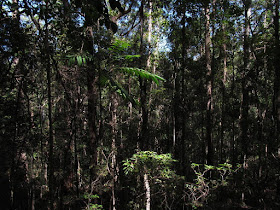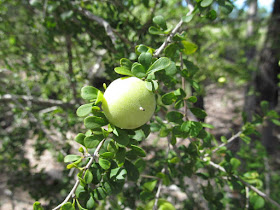One of the recurrent topics of this blog is the controversy around the acceptance of paraphyletic taxa. Although I have become a bit jaded over the years, my original stance was, and to a certain degree still is, that I am trying to understand the reasoning offered by colleagues who think that paraphyletic taxa are acceptable or even unavoidable. Because, who knows?, there may be a novel argument that shows cladism to be misguided after all, and I want to keep an open mind.
Sadly, however, it is mostly the same few talking points that lost the discussion in the 1970s and 1980s, resurfacing again and again. It is rare, although not unheard of, that a new and truly interesting argument is presented.
Today's candidate paper freshly online is
Baranow et al. 2017. Brasolia, a new genus highlighted from Sobralia (Orchidaceae). Plant Systematics and Evolution. DOI 10.1007/s00606-017-1413-zThe authors present phylogenetic analyses and change the classification of the titular orchid genus. The only point of interest for present purposes is that they argue for the recognition of Sobralia section Sobralia at the genus level despite that group being paraphyletic, and in what follows I do not want to imply any criticism of any other part of the publication or of the hard work the authors have put into their study. It is only the theory of classification that I like to hash out.
The argumentation in favour of paraphyletic taxa runs across three paragraphs in the discussion section. Let's see if I can learn something new!
In the light of phylogenetic outcomes, the proposed taxon is paraphyletic, which means that its species have a common ancestor, but the taxon does not include all its descendants (e.g., Elleanthus).Polyphyletic taxa also have a common ancestor, so by the reasoning implied here one could justify any classification whatsoever. I am consequently unsure what the point of this first sentence is.
Monophyly in its broader definition describes groups with a common ancestry, including both paraphyletic and monophyletic groups (sensu Hennig 1950); therefore, Hörandl and Stuessy (2010) advocate returning to this broader definition of monophyly and, adopting Ashlock's term, holophyly for monophyly s.str.Again I am afraid I must be missing the point. The controversy is really about whether we should consistently classify by relatedness or not. I don't mean to be uncharitable, but this could potentially be taken to mean the authors hope that recognising non-monophyletic taxa would become more palatable to mainstream systematists if one could hoodwink them into forgetting what monophyletic means. It would then be equivalent to hoping that your child will accept a mountain hike instead of the promised trip to the beach if you just said "mountains are also a kind of beach" with enough conviction. Nice try, but there will still be no swimming in the ocean, and little Tommy sees right through it.
Paraphyly is a natural transition stage in the evolution of taxa (Hörandl and Stuessy 2010). According to Brummitt (2002), paraphyletic taxa are ''products of the evolutionary process, which is left behind as evolution moves on to a new level of organization.''The logic of these quotations appears to be as follows: "We really, really want to recognise paraphyletic taxa. So we draw a paraphyletic taxon onto the phylogenetic tree. Look, cladist, there is a paraphyletic taxon in the evolutionary process! Why are you so unreasonable not to accept it?" Unfortunately, circular reasoning does not become more convincing just because it has been published somewhere and can now be cited.
To clarify, there are no paraphyletic taxa out there in nature; there is only a tree of life, and phylogenetic systematists consistently circumscribe taxa on that tree to be monophyletic, while 'evolutionary' taxonomists circumscribe some taxa on that tree to be paraphyletic.
We realize that this is in conflict with commonly accepted phylogenetic methods which declare that monophyly s.str. should be the only criterion for grouping organisms.A "phylogenetic method" is what produced the orchid phylogeny, so I assume what is meant here is "approach to classification". But whatever, that is not the point, so onwards.
However, a somewhat analogical situation has been recognized within Coelogyne (Gravendeel et al. 2001). In this case, the authors interpreted the morphology of the studied species as not corresponding to the cladograms, probably as a result of convergent evolution and they decided to maintain polyphyletic Coelogyne. Kolanowska and Szlachetko (2016) postulate to maintain paraphyletic Odontoglossum.This appears to be an instance of the argumentum ad populum, and not even very much populum at that. Consider: is it a good idea to shoot a stapler into your own foot? Okay, so there will have been at least two people in the history of humanity who have done that, so you could now cite them for support. But does that make shooting a stapler into your foot any more sensible? Exactly; a better argument is needed here.
Also, as I only realised some time after first drafting this, the senior author of the present paper is the same as in one of those two references. So this is apparently also an instance of the rarely seen ipse dixit. (It is, of course, valid to cite one's own prior research results, but in this case we are dealing not with an empirical question but simply with the argument that an action is acceptable because it is not unprecedented.)
Recognition of distinctive characters which have evolved in a group is essential for an understanding its evolution (Brummitt 2006).Quite the opposite, in my eyes: having an accurate classification is essential for understanding evolution, because paraphyletic taxa mislead us about relationships. In the present case, treating Elleanthus as a subgroup of Sobralia would (correctly) show that Elleanthus evolved out of Sobralia, whereas treating Sobralia and Elleanthus as separate genera implies (wrongly) that they are evolutionarily distinct units, side by side.
This point of view is shared by numerous other authors (Sosef 1997; Dias et al. 2005; Nordal and Stedje 2005) who state that traditional classification is the optimal tool for cataloging biodiversity and requires recognition of paraphyletic taxa.This reads like more argumentum ad populum, and sadly it is left unmentioned why paraphyletic taxa are supposedly required.
We decided to follow the Darwinian (evolutionary) classification, which requires consideration of two criteria: similarity and common descent.Leaving aside the obvious argument from name-checking here, which is exactly as relevant as using Newton to reject Einstein (and for the same reasons), the problem remains that trying to classify by two criteria at the same time will lead to a useless classification that is not reliably reflecting either.
Assume I have never heard of Sobralia before, and then it is mentioned to me for the first time. Given a phylogenetic classification, I know that it constitutes a natural group whose members are each other's closest relatives. Given a classification as argued for in the present paper, it could be a natural group... but it could also be a group defined by similarity that includes species more closely related to another genus than to any other species of Sobralia. I just won't know.
The approach will allow us to propose a classification based on the phylogenetic relationships, but at the same time it will be practical--with clearly defined and recognizable units.No, sorry to say so, but it quite simply will not. First, it will not be based on phylogenetic relationships, because in one crucial instance phylogenetic relationships will be ignored. Second, and again, it will not be practical, because if two criteria are mixed the end user cannot know without going back to the original publications whether a given group was circumscribed based on relatedness or based on 'similarity', see above.
Now obviously I understand that this is not a theory paper arguing for a wholesale shift in our practice of classification. What is more, I know we cannot expect all solutions to be easy or all groups immediately to be circumscribed as monophyletic the moment somebody looks at them. I can happily accept a paper concluding "we know this group is probably paraphyletic, but for the moment we don't have a better solution, let's wait until more data are in", or "the group is clearly polyphyletic, but at this moment we do not want to make hasty taxonomic changes", or something along those lines.
But the three paragraphs quoted above were specifically meant to justify the ultimate recognition of paraphyletic genera, so one would expect to find a convincing justification. Sadly I, personally, have to admit to being anti-convinced by this paper, which as previously mentioned I take to mean an argument had the effect of making me even more convinced of the idea it was meant to refute, in this case classification by relatedness.














